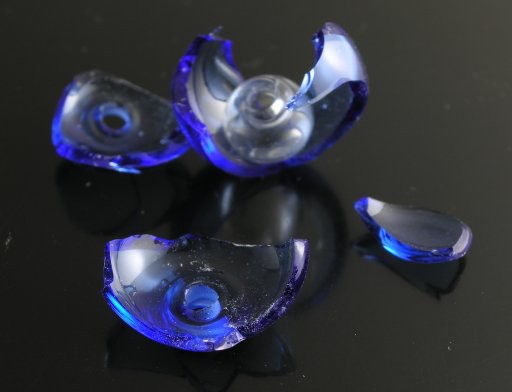So one thing that glass beadmakers aren't real thrilled to discuss in exhuastive detail (excepting how their particular product falls outside the norm) is breakage, even though it's a fact of life.
So, you are wondering, why should you purchase something so fragile? Well, the first thing to keep in mind is that glass actually is incredibly durable under certain circumstances, and so are beads, which are arguably amongst the oldest art objects humankind has made. Glass is remarkably resistant to random chemical change, which can convert even the toughest metal object into a pile of rust over time. Neither does glass rot, fade, or deform. It can, over thousands of years, become somewhat pitted.
However, it's brittle, and thus shatters. I've maintained over a period of years that hollow beads, particularly the small hollow beads I typically make, are remarkably resistant to breakage when dropped. However, if forces are applied from two directions, as with a nutcracker, they break. Fortunately, this set of circumstances rarely prevails—I know of only one small hollow that broke this way, when a customer put it an outside pocket of her backpack, which someone else smacked against it (or so she claimed, and I have no reason to disbelieve her. This is not to say I haven't any number of other cracked hollows, but they usually result from my heat-shocking them unnecessarily, or from incompatibility. The number broken from impact is, I would guess, is in the low dozens out of the thousands of beads I've made over the years. And I don't take particular pains over them, though I draw the line at sending my bead cases through airport luggage;) Double hollow beads, on the other hand, are more likely to break when dropped because the outer bead not only has to cope with the impact of the floor, but also the hammer-like force of the interior bead.

Double hollow. Soda-lime glass, jan 2006, roughly 20–25mm. I have to say, if I were going to lose one, this was the one, because colorless inside beads don't show much with darker tinted exterior beads—this bead never looked so interesting before it broke...
Moral of the story: putting round double hollow beads on a mildly sloped surface over a concrete floor, as I did while I was styling this bead for a photograph, is not a good idea. It rolled right off the plastic and onto the basement floor, and cracked. As you see the interior bead survived just fine, as hundreds of other small hollows I've dropped have done.
To be honest, I think determining the exact physics of two beads in a double hollow as it shatters would be quite interesting, and I'm one of the few people who could reasonably undertake the experiment. And, now that the wizard has purchased a little camcorder, it's one I'd like to try.
In the meantime, however, I recommend your not dropping double hollows onto hard surfaces, at least not till you've got a thread through them that will keep the inner bead from slamming into the outer—maybe put a piece of carpet under your work area while working with ’em?
file created 28jan07
Unless otherwise noted, text, image and objects depicted therein copyright 1996--present sylvus tarn.
Sylvus Tarn